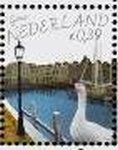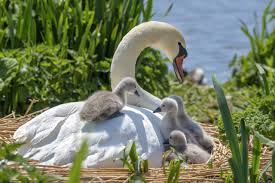Stamp: Harbour, Domestic Goose (Anser anser domestica) (Netherlands 2005)
Harbour, Domestic Goose (Anser anser domestica) (Netherlands 2005)
14 October (Netherlands ) within release Pretty Netherlands goes into circulation Stamp Harbour, Domestic Goose (Anser anser domestica) face value 0.39 Euro
| Stamp Harbour, Domestic Goose (Anser anser domestica) in catalogues | |
|---|---|
| Michel: | Mi:NL 2318c |
Stamp is vertical format.
Also in the issue Pretty Netherlands:
- Souvenir Sheet - pretty Netherlands face value 5*0.39;
- Souvenir Sheet - pretty Netherlands face value 5*0.39;
- Stamp - Harbour, Domestic Goose (Anser anser domestica) face value 0.39;
- Stamp - Erasmus Bridge, Rotterdam face value 0.39;
- Stamp - City Hall, Weesp face value 0.39;
- Stamp - Church and harbour, Monnickendam face value 0.39;
- Stamp - National Monument, Amsterdam face value 0.39;
- Stamp - Church and bridge, Roermond face value 0.39;
- Stamp - Church and bridge, Roermond face value 0.39;
- Stamp - Houses behind dike, Papendrecht face value 0.39;
- Stamp - Houses behind dike, Papendrecht face value 0.39;
- Stamp - Landscape in Overijssel face value 0.39;
- Stamp - Castle in Nijmegen face value 0.39;
- Stamp - Cityhall Bolsward face value 0.39;
Stamp Harbour, Domestic Goose (Anser anser domestica) it reflects the thematic directions:
A ship is a large watercraft that travels the world's oceans and other sufficiently deep waterways, carrying passengers or goods, or in support of specialized missions, such as defense, research and fishing. Historically, a "ship" was a sailing vessel with at least three square-rigged masts and a full bowsprit. Ships are generally distinguished from boats, based on size, shape and load capacity.
A port is a maritime facility comprising one or more wharves or loading areas, where ships load and discharge cargo and passengers. Although usually situated on a sea coast or estuary, ports can also be found far inland, such as Hamburg, Manchester and Duluth; these access the sea via rivers or canals. Because of their roles as ports of entry for immigrants as well as soldiers in wartime, many port cities have experienced dramatic multi-ethnic and multicultural changes throughout their histories
Birds (Aves), a subgroup of Reptiles, are the last living examples of Dinosaurs. They are a group of endothermic vertebrates, characterised by feathers, toothless beaked jaws, the laying of hard-shelled eggs, a high metabolic rate, a four-chambered heart, and a strong yet lightweight skeleton. Birds live worldwide and range in size from the 5 cm (2 in) bee hummingbird to the 2.75 m (9 ft) ostrich. They rank as the class of tetrapods with the most living species, at approximately ten thousand, with more than half of these being passerines, sometimes known as perching birds. Birds are the closest living relatives of crocodilians.
Swans are birds of the genus Cygnus within the family Anatidae. The swans' closest relatives include the geese and ducks. Swans are grouped with the closely related geese in the subfamily Anserinae where they form the tribe Cygnini. Sometimes, they are considered a distinct subfamily, Cygninae.
Animals are multicellular, eukaryotic organisms of the kingdom Animalia (also called Metazoa). All animals are motile, meaning they can move spontaneously and independently, at some point in their lives. Their body plan eventually becomes fixed as they develop, although some undergo a process of metamorphosis later on in their lives. All animals are heterotrophs: they must ingest other organisms or their products for sustenance.
A modern sailing ship or sailship is any large wind-powered vessel. Traditionally a sailing ship (or simply ship) is a sailing vessel that carries three or more masts with square sails on each. Large sailing vessels that are not ship-rigged may be more precisely referred to by their sail rig, such as schooner, barque (also spelled "bark"), brig, barkentine, brigantine or sloop. There are many different types of sailing ships, but they all have certain basic things in common. Every sailing ship has a hull, rigging and at least one mast to hold up the sails that use the wind to power the ship. The crew who sail a ship are called sailors or hands. They take turns to take the watch, the active managers of the ship and her performance for a period. Watches are traditionally four hours long. Some sailing ships use traditional ship's bells to tell the time and regulate the watch system, with the bell being rung once for every half hour into the watch and rung eight times at watch end (a four-hour watch). Ocean journeys by sailing ship can take many months, and a common hazard is becoming becalmed because of lack of wind, or being blown off course by severe storms or winds that do not allow progress in the desired direction. A severe storm could lead to shipwreck, and the loss of all hands. Sailing ships are limited in their maximum size compared to ships with heat engines, so economies of scale are also limited. The heaviest sailing ships (limited to those vessels for which sails were the primary means of propulsion) never exceeded 14,000 tons displacement. Sailing ships are therefore also very limited in the supply capacity of their holds, so they have to plan long voyages carefully to include many stops to take on provisions and, in the days before watermakers, fresh water.






